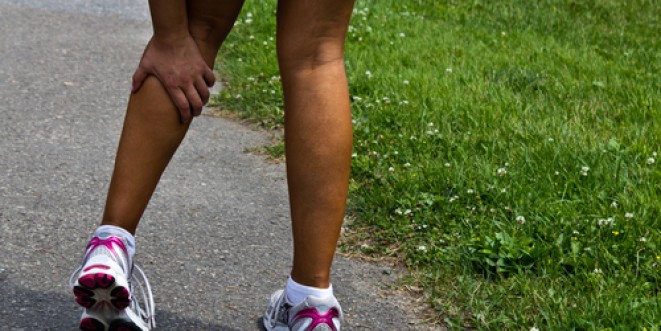How To Handle Post-Workout Muscle Soreness
By Patrick DalePublished: March 8, 2016

Fitness
If you exercise, at some point you are going to suffer from delayed onset muscle soreness, DOMS for short. While muscle soreness is common, it’s as yet unclear what causes your muscles to feel stiff and tender after some exercises and workouts. Current theories include:
- Accumulated lactic acid
- Waste products of metabolism
- Muscle fibre micro trauma
- Partial or complete muscle glycogen depletion
Whatever the cause, the symptoms can vary from mild discomfort to debilitating pain!
What triggers muscle soreness?
Muscle soreness is usually triggered by doing more exercise or exercising harder than usual. In some cases, it’s simply doing a different type of exercise. For example, if you normally do squats, switching to lunges can be enough to leave you feeling sore. DOMS normally comes on 12 to 24 hours after exercise and can last a day or two for mild cases and a week if you have really overdone it.
DOMS is not an indicator that you have had a good workout. And while many people wear their DOMS like a badge of honour, just because a workout left you limping with DOMS does not mean it was especially productive. It’s just a sign you have done more or something different than usual. Similarly, no DOMS does not mean you haven’t exercised hard enough.
It’s a mistake to try and induce DOMS simply for the sake of experiencing some muscle soreness and if DOMS is so severe that you are unable to walk comfortably or have to take time off exercise to let it pass, you have arguably done more harm than good.
The old adage “no pain, no gain” has been around for years but, unless you have masochistic tendencies, there is no need to purposely seek out DOMS!
Avoiding DOMS
If you have suffered from DOMS in the past and do not want to experience it again, there are several precautions you can take…
1) Always warm up properly and thoroughly. Make sure your warm up involves rehearsals of the exercises you are going to do in your workout.
2) Increase exercise intensity slowly. It can be very tempting to dive headlong into a new workout at maximum intensity. This is a sure-fire way to trigger DOMS. Instead, ease yourself into a new workout over a couple of weeks. For example, only do 50-70% of the prescribed reps and sets. Build up the intensity and volume of exercise gradually and you’ll experience far less DOMS.
3) Introduce new exercises over time. That way, you will avoid too many new movement patterns and reduce the likelihood of suffering DOMS. Rather than change your workouts overnight, change 1-2 exercises per week over a month until you are doing your new workouts in their entirety.
4) Cool down properly after your workout. It can be tempting to hit the showers the moment your workout is done but, to potentially prevent or reduce the severity of DOMS, spend a few minutes doing some light cardio to pump freshly-oxygenated blood around your body. Follow up with a light stretch of the working muscles.
5) Consume carbs immediately after exercise. This will help restore depleted muscle glycogen stores – a potential cause of muscle soreness.
Treating DOMS
Some people are more prone to DOMS than others and new exercisers are the most likely to suffer as almost anything they do will present a new and unusual challenge. Advanced exercisers often find it very hard to create the right environment for DOMS as they are already used to exercising hard and/or long.
If you experience DOMS, there are several things you can do to make it less uncomfortable, less debilitating and pass sooner…
1) Light cardio and stretching. Not an actual workout, but doing some light cardio and stretching can help iron out the kinks and get you moving smoothly again. Increasing muscle temperature and blood flow makes muscle more pliable and may flush out metabolic waste products.
2) Do a “50-percent” workout. The day after a hard, DOMS-inducing workout, do the same program but only use 50-percent of the weight, do 50-percent of the reps, and only 50-percent of the sets or distance. This should feel easy but is an excellent way to enhance recovery and alleviate DOMS.
3) Warm baths, saunas, and steam rooms. Passive heat opens up blood vessels and promotes circulation which may help flush away the materials believed to be responsible for DOMS. Even a warm shower can help.
4) Light massage. While DOMS-effected muscles might be tender to the touch, a light massage that focuses on increasing circulation and promoting blood flow may be beneficial. A deep tissue massage, such as a sports or Thai massage, would not be appropriate at this time and would undoubtedly be too painful to be beneficial.
5) Non-steroidal anti-inflammatories drugs. Over the counter medications such as Ibuprofen can help reduce the inflammation of DOMS but should only be used occasionally and for severe DOMS. Overuse of this type of medication is not recommended and the need for frequent use of NSAIDs would suggest that you are following an inappropriate workout routine.
DOMS should never be crippling or sought out on purpose. DOMS does not indicate a good workout, only that you have done something new. Suffering DOMS after each and every workout suggests you are doing more or working harder than your body is able to cope with. DOMS can also indirectly lead to injury by adversely affecting your ability to move properly. DOMS is a fact of life for exercisers but should only be an occasional acquaintance and not a life partner!
Did you enjoy this article? Sign up to receive weekly updates, health and fitness tips, plus our free eBook guide to get you started on achieving a leaner body, clearer skin and and healthy glow in just 10 days. It’s all free. Sign up here.
Like what you're reading? Sign up for our free newsletter and never miss a post! Plus get a FREE digital version of our Issue No.10 with sign up.

- Best Winter Workouts At Home, No Equipment Required - September 5, 2018
- The 15-Minute Fat Burning Workout for Busy Women - March 10, 2016
- How To Achieve Your Fitness Goals Even If The Year Is Almost Over - September 5, 2018
- Why You May Be Sedentary Even if You Exercise an Hour a Day and How to Change It - September 19, 2021
- 5 Newbie Fitness Mistakes And How To Avoid Them - April 5, 2016
- How To Handle Post-Workout Muscle Soreness - March 8, 2016
- When Is The Best Time of The Day To Work Out? - October 27, 2015
- New Step Up Interval Routine To Firm Up Your Bum - April 21, 2016
- Weekend Challenge: The Out And Back Run - April 15, 2016
- How To Avoid Knee Pain With Squat Exercise - February 23, 2016











